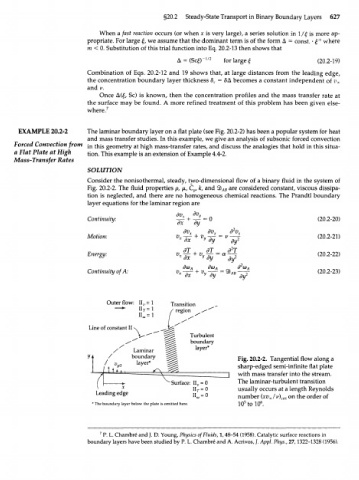Page 647 - Bird R.B. Transport phenomena
P. 647
§20.2 Steady-State Transport in Binary Boundary Layers 627
When a fast reaction occurs (or when x is very large), a series solution in 1 /f is more ap-
propriate. For large f, we assume that the dominant term is of the form Д = const. • £"' where
m < 0. Substitution of this trial function into Eq. 20.2-13 then shows that
A = (Scf) -1/2 for large f (20.2-19)
Combination of Eqs. 20.2-12 and 19 shows that, at large distances from the leading edge,
the concentration boundary layer thickness 8 C = 5Д becomes a constant independent of v x
and v.
Once A(£, Sc) is known, then the concentration profiles and the mass transfer rate at
the surface may be found. A more refined treatment of this problem has been given else-
where. 7
EXAMPLE 20.2-2 The laminar boundary layer on a flat plate (see Fig. 20.2-2) has been a popular system for heat
and mass transfer studies. In this example, we give an analysis of subsonic forced convection
Forced Convection from in this geometry at high mass-transfer rates, and discuss the analogies that hold in this situa-
a Flat Plate at High tion. This example is an extension of Example 4.4-2.
Mass-Transfer Rates
SOLUTION
Consider the nonisothermal, steady, two-dimensional flow of a binary fluid in the system of
Fig. 20.2-2. The fluid properties p, /л, С , k, and ЯЬ are considered constant, viscous dissipa-
р
АВ
tion is neglected, and there are no homogeneous chemical reactions. The Prandtl boundary
layer equations for the laminar region are
Continuity: (20.2-20)
~дХ ~ду ~~
Sv Sv
Motion: x x x (20.2-21)
V
ST ST
Energy: = (20.2-22)
Sx <Sy
Continuity of A: Sa) A VAB~ (20.2-23)
Outer flow: II, = 1 Transition
r
— + II =1 region
T
II. = 1
Line of constant II -
Turbulent
boundary
/ Laminar layer*
У 4 / boundary Fig. 20.2-2. Tangential flow along a
/ layer*
Vun sharp-edged semi-infinite flat plate
with mass transfer into the stream.
The laminar-turbulent transition
usually occurs at a length Reynolds
Leading edge = 0 number (xv /v) on the order of
5
6
* The boundary layer below the plate is omitted here. 10 tol0 . x crit
P. L. Chambre and J. D. Young, Physics of Fluids, 1,48-54 (1958). Catalytic surface reactions in
7
boundary layers have been studied by P. L. Chambre and A. Acrivos, /. Appl. Phys., 27,1322-1328 (1956).

